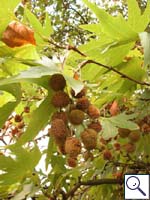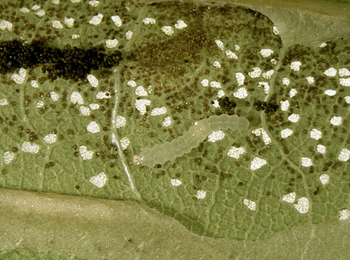|
||||||
|
PLATANUS. Planes. [Platanaceae] |
|
|
Two species and one subspecies of Platanus are recorded in in Britain. All are introduced and include London Plane (P. occidentalis x orientalis = P. x hispanica). Two British leaf-minera are recorded on Platanus. A key to the European miners recorded on Platanus is provided in Bladmineerders van Europa. |
 London Plane Platanus x hispanica |
|
Key for the identification of the known mines of British |
1a > Leaf-miner: Large mines, often several larvae in one leaf. Generally underside between veins. The upper side becomes mottled. On upper side can be over veins. The mine begins as an epidermal corridor, sometimes several cm in length. This widens into a shallow, greyish green, irregularly lobed blotch. The fully developed mine is an orange brown tentiform mine with a number of length folds. Almost all mines are lower-surface. The upperside of the mine then is a mottled oval, because the larva here and threre has eaten holes in the roof of the mine, i.e., the palissade parenchhyma. Pupation inside a white cocoon. |
 Phyllonorycter platani larva, dorsal Image: © Willem Ellis (Bladmineerders van Europa) |
|
Phyllonorycter platani (Staudinger, 1870) [Lepidoptera: Gracillariidae] |
1b > Leaf-miner: The mine is upper side and silvery, over the midrib. Leaf later may fold upwards, concealing the mine. Oviposition is on the base of the midrib. From there an epidermal corridor is made, running towards the leaf tip. The corridor then is widened into an epidermal, silvery blotch, finally into a longitudinally contracted tentiform mine. Frass in fine, shining grains, mostly in a line over the midrib, rarely in a mass in a corner of the mine. The epidermis of the mine has a number of yellow spots, but never the black specks that are apparent in P. corylifoliella. |
|
Phyllonorycter leucographella (Zeller, 1850) [Lepidoptera: Gracillariidae]. |
| Last updated 06-Jul-2019 Brian Pitkin | ||
